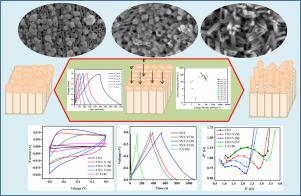当前位置:
X-MOL 学术
›
J. Electroanal. Chem.
›
论文详情
Our official English website, www.x-mol.net, welcomes your feedback! (Note: you will need to create a separate account there.)
Facile synthesis of titania nanotube- VO2(M) nanocomposites for high performance supercapacitors
Journal of Electroanalytical Chemistry ( IF 4.5 ) Pub Date : 2020-12-01 , DOI: 10.1016/j.jelechem.2020.114644 Kunnambeth M. Thulasi , Sindhu Thalappan Manikkoth , Anjali Paravannoor , Shajesh Palantavida , Margandan Bhagiyalakshmi , Baiju Kizhakkekilikoodayil Vijayan
Journal of Electroanalytical Chemistry ( IF 4.5 ) Pub Date : 2020-12-01 , DOI: 10.1016/j.jelechem.2020.114644 Kunnambeth M. Thulasi , Sindhu Thalappan Manikkoth , Anjali Paravannoor , Shajesh Palantavida , Margandan Bhagiyalakshmi , Baiju Kizhakkekilikoodayil Vijayan

|
Abstract In this work, we report the synthesis of titania nanotube (TNT) – monoclinic vanadium dioxide [VO2(M)] nanocomposites through a combined potentiostatic anodisation-hydrothermal procedure and its application in supercapacitors. Structural, morphological and chemical characterisations were done by XRD, FE-SEM and XPS analyses and electrochemical characterisations were done by CV, GCD and EIS. The TNT-VO2(M) nanocomposites exhibited very high capacitive performance as compared to their individual components, due to the synergistic contribution from both. Altered morphologies for composites were obtained at varying hydrothermal temperatures under similar conditions. The TNT-VO2(M) nanocomposite which is formed at 180 °C, TNT-V180 with VO2(M) nanorings over TNT showed the best CV performance in three electrode configuration with specific capacitance values ~152.21 mFcm−2 at scan rate 5 mVs−1 and confirmed by GCD and EIS. The open porous morphology with maximum available surface aided more charge accumulation at the electrode-electrolyte interface and better redox interaction with electrolyte ions resulting in its unique synergistic capacitive behaviour compared to others. The asymmetric supercapacitor fabricated with TNT-V180 as the negative electrode and active carbon (AC) as the positive electrode delivered a very high specific capacitance of 246.67 mFcm−2 with an ultra-high energy density of 111 μWhcm−2 at 180 μWcm−2 power density.
中文翻译:

用于高性能超级电容器的二氧化钛纳米管-VO2(M)纳米复合材料的简便合成
摘要 在这项工作中,我们报告了二氧化钛纳米管 (TNT) - 单斜二氧化钒 [VO2(M)] 纳米复合材料通过恒电位阳极氧化-水热法合成及其在超级电容器中的应用。结构、形态和化学表征通过 XRD、FE-SEM 和 XPS 分析完成,电化学表征通过 CV、GCD 和 EIS 完成。由于两者的协同作用,TNT-VO2(M) 纳米复合材料与其单个组件相比表现出非常高的电容性能。在类似条件下,在不同的水热温度下获得了复合材料的改变形态。在 180 °C 下形成的 TNT-VO2(M) 纳米复合材料,在 TNT 上带有 VO2(M) 纳米环的 TNT-V180 在三电极配置中表现出最佳的 CV 性能,在扫描速率为 5 mVs-1 时具有~152.21 mFcm-2 的比电容值,并由 GCD 和 EIS 证实。具有最大可用表面的开放多孔形态有助于在电极 - 电解质界面处积累更多的电荷,并与电解质离子更好的氧化还原相互作用,导致其与其他物质相比具有独特的协同电容行为。以 TNT-V180 作为负极和活性炭 (AC) 作为正极制造的非对称超级电容器提供了 246.67 mFcm-2 的非常高的比电容,在 180 μWcm-2 时具有 111 μWhcm-2 的超高能量密度功率密度。具有最大可用表面的开放多孔形态有助于在电极 - 电解质界面处积累更多的电荷,并与电解质离子更好的氧化还原相互作用,导致其与其他物质相比具有独特的协同电容行为。以 TNT-V180 作为负极和活性炭 (AC) 作为正极制造的非对称超级电容器提供了 246.67 mFcm-2 的非常高的比电容,在 180 μWcm-2 时具有 111 μWhcm-2 的超高能量密度功率密度。具有最大可用表面的开放多孔形态有助于在电极 - 电解质界面处积累更多的电荷,并与电解质离子更好的氧化还原相互作用,导致其与其他物质相比具有独特的协同电容行为。以 TNT-V180 作为负极和活性炭 (AC) 作为正极制造的非对称超级电容器提供了 246.67 mFcm-2 的非常高的比电容,在 180 μWcm-2 时具有 111 μWhcm-2 的超高能量密度功率密度。
更新日期:2020-12-01
中文翻译:

用于高性能超级电容器的二氧化钛纳米管-VO2(M)纳米复合材料的简便合成
摘要 在这项工作中,我们报告了二氧化钛纳米管 (TNT) - 单斜二氧化钒 [VO2(M)] 纳米复合材料通过恒电位阳极氧化-水热法合成及其在超级电容器中的应用。结构、形态和化学表征通过 XRD、FE-SEM 和 XPS 分析完成,电化学表征通过 CV、GCD 和 EIS 完成。由于两者的协同作用,TNT-VO2(M) 纳米复合材料与其单个组件相比表现出非常高的电容性能。在类似条件下,在不同的水热温度下获得了复合材料的改变形态。在 180 °C 下形成的 TNT-VO2(M) 纳米复合材料,在 TNT 上带有 VO2(M) 纳米环的 TNT-V180 在三电极配置中表现出最佳的 CV 性能,在扫描速率为 5 mVs-1 时具有~152.21 mFcm-2 的比电容值,并由 GCD 和 EIS 证实。具有最大可用表面的开放多孔形态有助于在电极 - 电解质界面处积累更多的电荷,并与电解质离子更好的氧化还原相互作用,导致其与其他物质相比具有独特的协同电容行为。以 TNT-V180 作为负极和活性炭 (AC) 作为正极制造的非对称超级电容器提供了 246.67 mFcm-2 的非常高的比电容,在 180 μWcm-2 时具有 111 μWhcm-2 的超高能量密度功率密度。具有最大可用表面的开放多孔形态有助于在电极 - 电解质界面处积累更多的电荷,并与电解质离子更好的氧化还原相互作用,导致其与其他物质相比具有独特的协同电容行为。以 TNT-V180 作为负极和活性炭 (AC) 作为正极制造的非对称超级电容器提供了 246.67 mFcm-2 的非常高的比电容,在 180 μWcm-2 时具有 111 μWhcm-2 的超高能量密度功率密度。具有最大可用表面的开放多孔形态有助于在电极 - 电解质界面处积累更多的电荷,并与电解质离子更好的氧化还原相互作用,导致其与其他物质相比具有独特的协同电容行为。以 TNT-V180 作为负极和活性炭 (AC) 作为正极制造的非对称超级电容器提供了 246.67 mFcm-2 的非常高的比电容,在 180 μWcm-2 时具有 111 μWhcm-2 的超高能量密度功率密度。


























 京公网安备 11010802027423号
京公网安备 11010802027423号